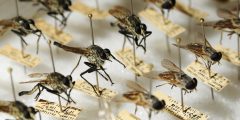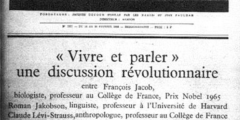The microbe/gene drive communication confusion
September 27, 2019
Last week I wrote a post about how genetic modification and/or gene drive are used when managing disease transmitting insects. I want to come back to this topic today and talk about another difference, which, yet again, confused me. I hope that these efforts of disentangling stuff also help other people trying to understand and …
The GM/gene drive communication confusion
September 20, 2019
The other day, I was at the airport waiting for a plane back to the UK, when I noticed on twitter that there was some kerfuffle going on about a field trial in Brazil intended to eliminate disease carrying mosquitoes, which had had, it seems, some unintended consequences (see study). Here is a short summary: …
Grace de Laguna: A forgotten pioneer in the history of the language sciences
August 30, 2019
Recently I was asked to write something about Grace de Laguna. Grace de what… I wondered… until I googled myself and found that I had written a few pages about her work in my 1996 book on the history of pragmatics. That was a blast from the past! But this also made me think. I …
Epi-pins: Epigenetics on Pinterest
August 23, 2019
This post has been co-authored with Cath Ennis, University of British Colombia, Vancouver (author of Epigenetics: A Graphic Guide). Cath is a Knowledge Translation Specialist with the University of British Columbia’s Human Early Learning Partnership and the Kobor Lab at BC Children’s Hospital Research Institute. *** Cath and I are interested in how epigenetics is …
A Whole New (re-cycled) World? An interdisciplinary conversation about the Circular Economy, Synthetic Biology and Sustainability Goals
August 21, 2019
This is a guest post by Penny Polson, Carmen McLeod, Sarah Hartley and Eleanor Hadley Kershaw *** Introduction to the Circular Economy The notion of a ‘circular economy’ has been gaining a lot of traction lately. The Ellen MacArthur Foundation, in particular, has raised the profile of this radical rethinking of how consumer goods are …
On the division of social knowledge and its breakdown
August 16, 2019
Most social scientists reading this title will think, aha that’s modelled on Émile Durkheim’s De La Division du Travail Social (The Division of Labour in Society) (1893). They ‘know’ that book; at least its title. It’s part of their knowledge repertoire. What’s underneath the title may not go very deep or may be forgotten, as in …
Poo and puns: Recent representations of faecal microbiota transplants in English language news media
August 9, 2019
This post, by Carmen McLeod, Brigitte Nerlich and Rusi Jaspal, has recently been published on the Microbiology Society Blog. We reblog it here with permission. *** Bacteria, germs, poo…these are words that normally don’t evoke images of health and happiness. The relationship between humans and bacteria is often understood as a combative one. Bacteria are …
Heritable Genome Editing: National and international governance challenges and policy options
July 27, 2019
This blog post has been co-authored with Achim Rosemann (University of Exeter). A shorter and slightly different version has been published by the BioMed Central ‘On Society’ Blog. *** Germline gene editing has become a hot topic in science and in society, after one Chinese scientist edited embryos in 2018, an experiment that a Russian …










